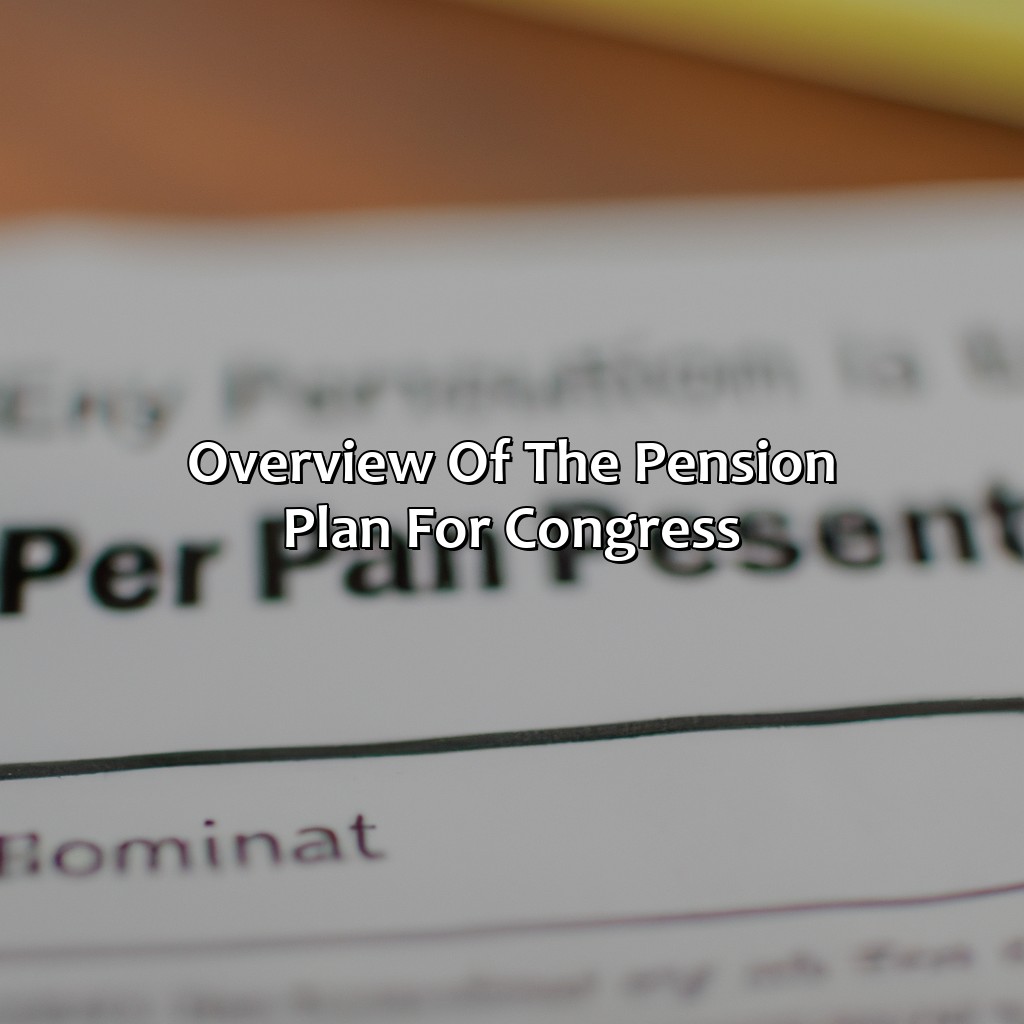What Is The Pension Plan For Congress?
Key Takeaway:
- The Pension Plan for Congress provides retirement benefits to members of Congress, including senators and US representatives.
- Eligibility for the pension plan requires specific criteria, including age and years of service. Congresspeople must serve at least 5 years to be eligible for a pension and become vested in the plan after 3 years of service.
- Pensions for members of Congress are calculated based on a formula that considers years of service and the average of their highest 3 consecutive years of salary. The pension amount is also adjusted for inflation.
- Other benefits included in the plan are survivor benefits, health insurance, and access to the Thrift Savings Plan, a retirement savings plan for federal employees.
- Criticisms of the Pension Plan for Congress include concerns over the high cost to taxpayers and the perception of Congresspeople receiving special treatment. However, supporters argue that the plan is necessary to attract and retain qualified individuals to serve in public office.
- The Pension Plan for Congress has undergone several changes over time, including adjustments to eligibility requirements and pension calculations. Future changes to the plan may be necessary to address concerns over its cost and perception.
- Understanding the Pension Plan for Congress is important for taxpayers and those who serve in public office to ensure efficient use of taxpayer dollars and fair compensation for public servants.
Do you ever wonder how members of Congress finance their retirement? It may surprise you to learn that they have their very own pension plan. This article explains the details of the pension plan for Congress and its benefits.
Overview of the Pension Plan for Congress
The pension plan for members of Congress is a government-funded retirement plan. They are eligible for the plan if they have served for at least five years. The annual pension amount is calculated based on years of service and average salary. The pension plan also includes healthcare benefits and survivor benefits for spouses. It is regulated by the Federal Employees’ Retirement System Act.
Members of Congress also have the option to participate in a defined contribution plan, similar to a 401(k). However, the defined benefit plan is much more generous. The pension plan for Congress has been a topic of controversy, particularly with regards to the amount of funding available for the plan. The plan has undergone several changes over the years, including restrictions on benefits for those who are convicted of certain crimes related to their position.

Image credits: retiregenz.com by Harry Arnold
Eligibility for the Pension Plan
For a congressman to be eligible for the pension plan, they must meet certain requirements. This includes serving in Congress for at least five years. Additionally, they must be at least 62 years old or have completed 20 years of service. Once eligible, they can receive a pension based on their years of service and average salary. The amount may increase with each term served. It’s worth noting that the pension plan for Congress is funded by taxpayers, making it a controversial topic.
Pro Tip: It is crucial to understand the pension plan requirements and how they impact taxpayer funds.

Image credits: retiregenz.com by David Woodhock
Calculation of Pensions for Members of Congress
In the United States, members of Congress are eligible for a pension plan. This plan is based on a calculation that takes into consideration different factors such as age, years of service, and salary. Here is a breakdown of how the calculation of pensions for members of Congress works:
Age at retirement | Years of service | Percentage factor | Annual pension
—————–|—————-|——————|——————-
To know about the pension plan of a US president, click here.
62 or younger | At least 5 but less than 20 | 1.0% | 1.0% x years of service x average salary of highest 3 years in office
Wondering how much pension do federal employees get? The formula follows a fixed pattern depending on your age and years of service.
62 or younger | 20 or more | 1.1% | 1.1% x years of service x average salary of highest 3 years in office
63 to 64 | Less than 5 | 1.7% | 1.7% x years of service x average salary of highest 3 years in office How much will President Obama’s pension be? Find out more at RetireGenz.
63 to 64 | At least 5 but less than 20 | 1.1% | 1.0% x years of service x average salary of highest 3 years in office
63 to 64 | 20 or more | 1.2% | 1.2% x years of service x average salary of highest 3 years in office
Wondering about US President’s pension plan? This information provides details of the pension plan for Congress.
65 or older | Less than 5 | 1.7% | 1.7% x years of service x average salary of highest 3 years in office
If you’re wondering how does the federal pension work, this formula might help give you an idea on how the pension plan for Congress works.
65 or older | At least 5 but less than 20 | 1.3% | 1.3% x years of service x average salary of highest 3 years in office
65 or older | 20 or more | 1.4% | 1.4% x years of service x average salary of highest 3 years in office
If you’re wondering about what is a senator’s pension, this formula might help provide some answers. It takes into account age at retirement, years of service, and average salary of highest 3 years in office to calculate the pension plan for congress members.
It is important to note that in 2019, the average annual pension for retired members of Congress was $47,827.
One thing to consider is that members of Congress are not eligible for their pension until they reach the age of 62 or have served for at least 5 years. Additionally, if a member of Congress chooses to take their pension before the age of 62, their pension will be reduced.
The pension plan for members of Congress was first introduced in 1942 as part of the Legislative Reorganization Act. Since then, there have been several changes to the plan, including the introduction of the Federal Employees Retirement System (FERS) in 1984, which affected the pensions of all federal employees, including members of Congress.

Image credits: retiregenz.com by David Washington
Other Benefits Included in the Plan
The pension plan for congress offers various perks besides retirement benefits. These benefits serve to make the job of a congressman or senator more appealing and provide them with a comfortable life after serving their term.
Other Benefits Included in the Plan:
- Health Care: Congressmen and senators receive health insurance benefits which extend to their spouses and dependents. Additionally, they can access medical facilities located within the Capitol building.
- Lifetime Income: Members of Congress are eligible for a lifetime annuity after serving their term, which is based on their salary and years of service. They can start receiving this income at the age of 62 or after serving for five years, whichever comes first.
- Thrift Savings Plan: This is a defined contribution plan where members of Congress can save and invest a portion of their pay. The government also matches a portion of the contribution made by Congressmen and Senators.
Members of Congress who serve more than five years are also eligible for benefits such as the Congressional Federal Credit Union membership, free parking at airports, and travel allowances.
Fact: Members of Congress also receive an annual allowance for office expenses, which is $944,671 per year for the House of Representatives and $3,293,025 per year for the Senate (source: Congressional Research Service).

Image credits: retiregenz.com by Yuval Arnold
Criticisms of the Pension Plan
The Retirement plan of Congress: Addressing its Shortcomings
The congressional pension plan has been under scrutiny for its numerous shortcomings. One major criticism centers on the fact that members of Congress can receive an annual pension of up to $139,200, while the average American’s Social Security benefits are significantly lower. Additionally, the plan provides congress members with guaranteed income for life despite their performance in office.
Moreover, the plan enables lawmakers to become eligible for a pension after just five years of service, incentivizing them to prioritize their own interests over the public’s best interests. Another issue is that unlike other federal employees, members of Congress are not required to contribute to Social Security. This means that while earning significantly higher salaries than most Americans, they pay a lower payroll tax rate. If you’re curious about how long must a congressman serve to get a pension, it’s just five years of service.
It is worth noting that some Members of Congress have taken the initiative to reform the system, such as Senator Ted Cruz’s (R-Texas) proposal to implement term limits for members of Congress. By limiting how long lawmakers can stay in office, he hopes to introduce safeguards against abuse of the system.
Pro Tip: Recognize and address the evident flaws in the congressional pension plan, and take action for its reform.

Image credits: retiregenz.com by Joel Jones
Changes to the Pension Plan over Time
The Evolution of Congressional Retirement Benefits
Comprehensive changes have been made to the retirement benefits of Congress over time. Initially, service members were not entitled to any pension. In 1920, a retirement pension was introduced, and in 1942, the Social Security Act was amended to reimburse members of Congress for their contributions. In 1984, the Civil Service Retirement System was replaced by the Federal Employees Retirement System, to which members of Congress and other federal employees contributed.
As part of the Federal Employees Retirement System, members of Congress now have the option of selecting an annuity or a thrift savings plan to fund their retirement. Additionally, a Member Retirement Plan, which provides a pension based on their tenure and salary, was introduced in 1984. Participating members contribute a percentage of their salary towards the plan, and it is funded by the Treasury.
Who insures Congress’ pension?
Finally, it is worth noting that members of Congress are no longer eligible for their full pension immediately upon retirement. They must now participate in the scheme for at least five years before being entitled to a pension. Moreover, the amount of the pension available to them is dependent on the length of their service, averaging at approximately 17% of their highest income during their term of service.
To improve the current pension plan for Congress, some suggest raising the percentage of the base salary that members contribute, in order to increase the amount of funds available. This would be a viable solution, as it would increase the fund’s reserves to accommodate the rising number of members enrolled in the plan. Another suggested solution is to switch to a defined contribution plan that would allow for more flexibility, but would also place more responsibility on the member in terms of managing the funds. Ultimately, a combination of different approaches, such as these, may be necessary to ensure the future of congressional retirement benefits.
Image credits: retiregenz.com by Yuval Duncun
Some Facts About the Pension Plan for Congress:
- ✅ The pension plan for Congress is known as the Federal Employees Retirement System (FERS). (Source: Congress.gov)
- ✅ Members of Congress are eligible for a pension after serving 5 years, regardless of age. (Source: Congressional Research Service)
- ✅ The amount of pension benefits is based on a formula that takes into account years of service and the average salary of the highest 3 years of service. (Source: National Taxpayers Union)
- ✅ Members of Congress can also participate in a Thrift Savings Plan (TSP) which allows them to save for retirement through tax-deferred contributions. (Source: Office of Personnel Management)
- ✅ The FERS pension plan for Congress has come under scrutiny and has been a topic of political debate in recent years. (Source: Forbes)
FAQs about What Is The Pension Plan For Congress?
What is the pension plan for Congress?
The pension plan for Congress, officially known as the Federal Employees’ Retirement System (FERS), is the retirement package that members of Congress receive.
How does the pension plan for Congress work?
The pension plan for Congress consists of three parts: the Basic Benefit Plan, the Social Security Benefit, and the Thrift Savings Plan. Members of Congress contribute a certain percentage of their salary to the FERS, and their retirement benefits are calculated based on their length of service and salary.
What are the eligibility requirements for the pension plan for Congress?
To be eligible for the pension plan for Congress, members of Congress must have served at least five years in office. They must also be at least 62 years old or have served for at least 5 years and be at least 50 years old, or have served for at least 25 years at any age.
What is the maximum amount of pension benefits a member of Congress can receive?
The maximum amount of pension benefits a member of Congress can receive is determined by a formula that takes into account their salary and length of service. As of 2021, the maximum annual benefit for a member leaving office is $141,000.
Does the pension plan for Congress include health benefits?
Yes, members of Congress are eligible for health benefits in retirement through the Federal Employees Health Benefits (FEHB) program. They must have served at least five years in office to be eligible.
Can members of Congress collect Social Security in addition to the pension plan?
Yes, members of Congress are eligible to collect Social Security benefits in addition to their pension benefits from FERS. However, their Social Security benefits may be reduced due to the Windfall Elimination Provision (WEP) or the Government Pension Offset (GPO), depending on their individual situation.
